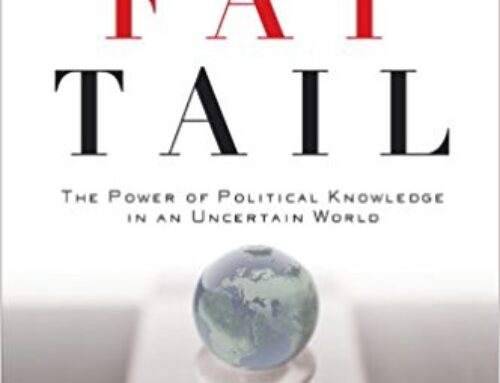David Apgar
Comment by: Lorenzo Preve
This is an interesting book in Risk Management; it stresses the importance of separating learnable from non-learnable risks, and design strategies according to this.
It is not my style of book, but overall I have enjoyed reading it. I will provide a short summary of the book by going over the main concepts of each chapter.
Chapter 1 presents a general approach to risk management and focuses in the organization’s ability to learn about the risks it is assuming. The general idea of the chapter is that a risk can be random or learnable, and a risk could be learnable for some firms and random for some others. The author states that the company needs to choose risk that can learn about, and “we must know what we are good at learning”. The chapter offers four rules that are the response to four myths; they are:
+Myth 1: All Risks are Random. Rule 1: Recognize which risks are learnable.
+Myth 2: Since Risk average out, they rarely create persistent winners and losers. Rule 2: Identify risks you can learn about fastest
+Myth 3: There is no pattern to how risks evolve. Rule 3: Sequence Risky Projects in a “learning pipeline”
+Myth 4: Business Partners get the same results no matter how they allocate the risks. Rule 4: Keep networks of partners to manage all risks
Chapter 2 presents the book’s First Rule: Recognize which risks are learnable. This Chapter separates non-random “learnable” risks from random ones, bearing in mind that our relative risk assessment skills might affect the distinction. The author recognizes the importance of learning what drives learnable risks. The chapter states that the risk assessment ability becomes a critical skill that determines success. The chapter’s bottom line is a strong urge to differentiate learnable from non-learnable (random) risks, and states that as a rule of thumb, a random risk usually depend on a well-established and efficient market.
Chapter 3 presents the book’s Second Rule: Identify Risks you can learn about faster. The Chapter focuses on the managerial ability to assess different kinds of learnable risks. It is not the ability to manage risks, but the organization’s ability to learn about them what is discussed in this chapter. The author proposes a five steps test that is designed to help the reader’s assess their ability to learn about their risks, and promises that it helps improving these abilities as well. The chapter closes by characterizing the ability to assess risk, dividing people in Impressionists (lots of memorable experiences but lack of ability of applying it in the right situations), Encyclopedists (lots of superficial knowledge), and Amnesiacs (lots of knowledge that they do not share with others). This chapter makes a point in trying to build teams that combine the three types of risk assessors.
Chapter 4 presents the book’s Third Rule: Sequence risky projects in a “learning pipeline”. The Chapter focuses on the importance of having a strategy regarding the way we interact with risks. It stresses the importance of learning one risk at a time, and to continually improve our ability to learn about risks. This chapter combines the concepts of “pipelines of risks” and “portfolio of risks” getting the best of their interaction. These two concepts are interconnected in the Risk Strategy Matrix that relates the Risk Correlations and our Ability to Assess it. This matrix shows the life cycle of risks. The chapter presents the “Risk Audit Strategy” that ends in a matrix that present all the company’s projects in a Risk Diversification and Risk Intelligence space. Then the author relates this matrix with BCG’s Growth-Share Matrix.
Chapter 5 presents the book’s Fourth Rule: Keep networks of partners to manage all risks. The Chapter introduces the Risk-Role Matrix, which relates Risk Diversifiability with Market Intensity, and uses it to explain the position of our firm in a network. Risk diversifiability, a concept introduced in Ch. 4, is related with the correlation between the different risks in our portfolio, and market intensity is affected by the correlation of our risks with the economy (the author uses the S&P500 as a benchmark for the economy). The idea is that, according to where is our project located in this matrix, we should play a different role in our risk network; here the author uses the terms, “customer umbrella”, “classic borrower”, “shock absorbers”, and “risk distributors” as roles depending on where is our firm located in the matrix. The chapter relates the choice of where the company should be located, to its financial situation. The chapter moves on to the discussion of the so-called “flat-field” risks; those risks that nobody can know better than the rest of the market. The author gives a nice example about their importance explaining how creating a flat-field risk helped Mexico solving its debt problem (Dizard’s Index). The chapter ends exploring what we have learned so far and its implications in expansion to emerging markets.
Chapter 6 provides a ten-step story of risk intelligence that, according to the author, will help the reader rethinking its business and the economy. The steps are related to the Rules of Risk Intelligence outlined in the book. The ten steps are: (1) Choose projects, problems and ventures with learnable risks in mind, (2) Score your intelligence for the options you are considering and triage them, (3) Look for patterns in your risk intelligence scores and try to improve them, (4) Conduct a risk strategy audit for your main activities, (5) Classify your new risk pipeline in terms of gaps that threaten growth, (6) Compare the risk-role matrix for your activities with your risk partner networks, (7) Compare the risk roles that fit your organization with what fits your risks, (8) Look for opportunities to transform learnable risks into flat-field risks, (9) Check whether your launch market for an idea is relevant to your target market, (10) Look for opportunities to break the compromise between risk and growth.
Overall, the book was interesting. It is not my style, too many lists and recipes, but I understand that it might add significant value to the reader that values that.




